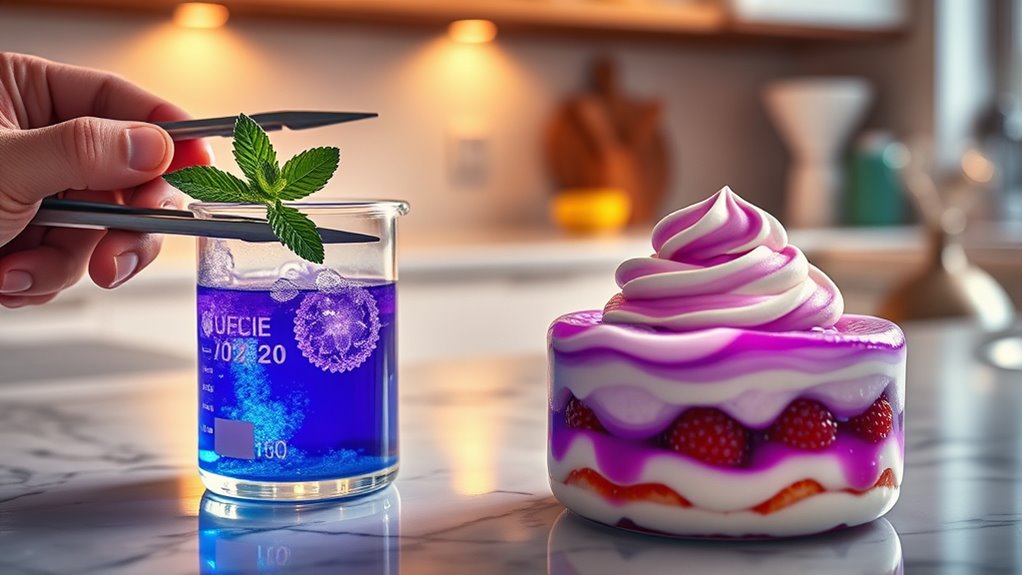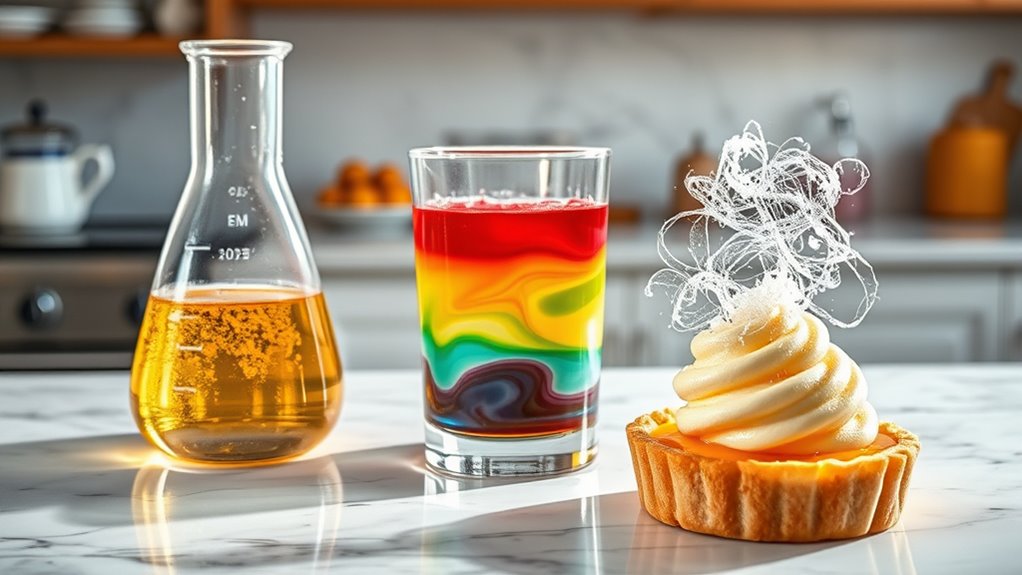You can turn simple kitchen ingredients into delicious desserts through fermentation experiments that also teach science. Try making yogurt at home by fermenting milk with bacteria, creating a creamy, tangy treat. You can also make fruit-kombucha by fermenting sweetened tea with yeast and bacteria—perfect for a fizzy dessert. Finally, experiment with naturally fermented fruit preserves or chutneys that develop complex flavors over time. Continue exploring these techniques to reveal tasty desserts and deepen your understanding of kitchen science.
Key Takeaways
- Fermentation experiments like making yogurt or kefir produce edible, probiotic-rich desserts through controlled microbial activity.
- Creating fruit-based ferments, such as fermented berries or apples, yields tangy, naturally sweet desserts.
- Using simple ingredients like salt, sugar, and lemon juice to ferment vegetables can turn them into flavorful, edible treats.
- Adjusting pH levels during fermentation enhances flavor and safety, transforming everyday ingredients into dessert-like dishes.
- Monitoring fermentation progress with pH measurements ensures consistent, delicious results suitable for serving as dessert.

Have you ever wondered how everyday kitchen activities involve science? It’s fascinating to realize that simple tasks like baking bread or making yogurt are rooted in complex chemical reactions. One key aspect of these processes is fermentation, a natural transformation that relies on microorganisms like yeast and bacteria. When you set out to make sourdough or ferment vegetables, you’re essentially guiding microbial activity to produce desired flavors and textures. The science behind fermentation processes involves controlling conditions so that these microbes thrive and produce byproducts like alcohol, lactic acid, or carbon dioxide. These byproducts are what give baked goods their rise, tangy flavors, and bubbly textures.
Kitchen science reveals how microbes create flavors, textures, and leavening through fermentation and pH control.
A vital part of managing fermentation is adjusting the pH level. The pH level influences microbial activity, as different microbes thrive at different acidity levels. By adjusting the pH level through adding ingredients like salt, vinegar, or lemon juice, you can steer the fermentation in a favorable direction. For example, when making sauerkraut, you want the environment to be slightly acidic to encourage beneficial bacteria while inhibiting spoilage organisms. You might start by salting the cabbage, which draws out moisture and helps lower the pH. Over time, the natural fermentation process kicks in, converting sugars into lactic acid, which preserves the vegetables and gives them that signature tang.
Understanding pH level adjustments isn’t just useful for preserving food; it also enhances flavors. When fermenting dairy into yogurt, controlling the pH ensures the bacteria produce the right amount of acidity for a creamy texture and tangy taste. Similarly, in baking, adjusting the pH can influence the activity of leavening agents like baking soda or baking powder, which release carbon dioxide to make your baked goods rise. This is where science directly impacts your kitchen success.
Experimenting with fermentation and pH adjustments isn’t just educational—it’s delicious. By observing how pH levels shift during fermentation, you get a better grasp of how microbes transform ingredients. This knowledge allows you to fine-tune recipes, ensuring consistent results every time. Plus, it’s rewarding to see how a simple mixture of vegetables, salt, and patience can turn into a tangy, probiotic-rich side dish. These processes show that science isn’t just for labs; it’s right there in your kitchen, making your cooking more intentional and flavorful. When you understand the comparative advantage of different microorganisms, you can optimize fermentation techniques for better flavors and textures. So next time you’re fermenting or adjusting pH, remember—you’re conducting a mini science experiment that doubles as tonight’s dessert.
Frequently Asked Questions
Can These Experiments Be Done Safely With Children?
You wonder if these experiments are safe with children. With proper child supervision, they can be a fun, educational activity. Always check for allergy precautions beforehand, especially with ingredients like eggs, dairy, or nuts. Keep a close eye on kids during the experiments to prevent accidents. By taking these safety measures, you guarantee a safe, enjoyable experience that sparks their curiosity about science and cooking.
What Household Ingredients Are Best for Kitchen Science Experiments?
Imagine turning your kitchen into a science playground. You’ll want to gather simple, safe ingredients like food coloring and baking soda, which are perfect for experimental fun. Food coloring adds vibrant effects, while baking soda reacts with acids, creating fizzy excitement. These household staples are not only easy to find but also safe for kids, making your science adventures both entertaining and educational.
Are Any of These Experiments Suitable for Allergies or Dietary Restrictions?
You wonder if these kitchen science experiments suit allergies or dietary restrictions. Many experiments can be adapted with allergy-friendly options, like using plant-based milks or gluten-free flours. You can also explore dietary substitution ideas, such as swapping out common allergens for safe alternatives. Always read ingredient labels carefully, and consider allergy-free substitutes to guarantee everyone can enjoy the fun without health concerns.
How Long Do the Experiments Typically Take to Complete?
When considering timing considerations, the experiment duration varies depending on the specific activity. Some experiments may only take 10 to 15 minutes, ideal for quick fun, while others might require 30 minutes or more for complete results. You should plan accordingly, allowing extra time for preparation and cleanup. Keep in mind that longer experiments often involve more complex steps, so pacing yourself guarantees a smooth and enjoyable experience.
What Tools or Equipment Are Necessary for These Experiments?
For these experiments, you’ll need basic measuring tools like cups, spoons, or a scale to guarantee accuracy. Safety gear such as oven mitts, aprons, and goggles is essential to keep you safe, especially with hot or sharp ingredients. Having these tools on hand makes the process smoother and safer, allowing you to focus on the fun of turning science into a delicious dessert without worries.
Conclusion
Now that you’ve tried these fun experiments, you see how science and dessert blend perfectly. For example, the caramelization process isn’t just about sweetness—it’s a chemical reaction transforming sugar into a rich, flavorful treat. By exploring these kitchen experiments, you uncover the science behind everyday cooking. So next time you bake or cook, remember: your kitchen is a lab where curiosity turns into delicious discoveries. Keep experimenting and savoring the sweet results!










